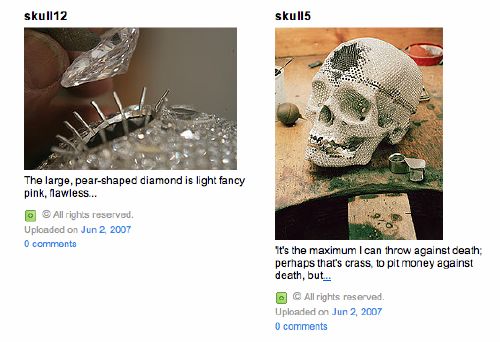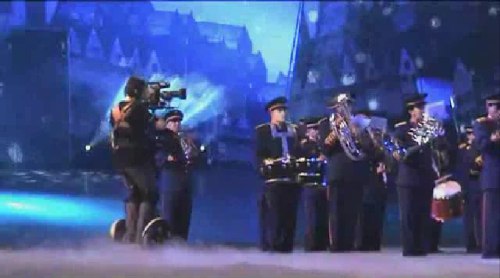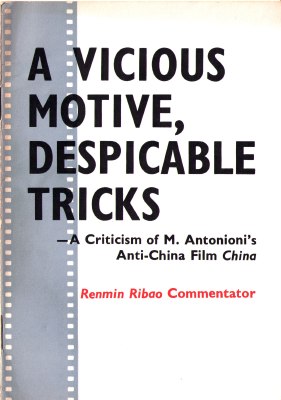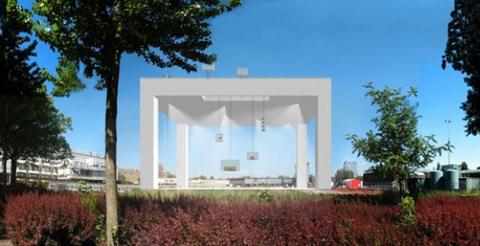Quadriceptica II is an amazing exhibition of which the Cultural Directorate of Rjamusz can be justly proud, and to which anyone seriously interested in pan-national trends in current post-market cultural production must direct themselves before the onset of locust season.
The first question to be asked is immediately answered on page 857 of the multilingual (English, French, German, Italian, Greek, Latin and Mandarin) catalogue. Quadriceptica II is being held now instead of next year (2008) because of the insight of Walter Zor, who is the President of Quadriceptica, LLC, as well as executive director of the Rjamuszan Cultural Directorate and Mayor of Belikk. As he told those of us who attended the gala press preview on the scenic rocky beach just a few kilometers’ vigorous and refreshing walk from Olde Belikk, he had been reading in the international media about America’s presidential primaries campaign, and about how each state seemed to be moving its primary to an earlier and earlier date in order to, as Mr. Roz [sic] put it in a typically Rjamuszan way, "get a jump on the competition." Quadriceptica II thus makes an intervention in the current discourse at least six months ahead of any of the 2008 polyennials.
Lisa Evelyn-Radish's parody on artnet of the proliferation of biennials would be a heckuvalot funnier if it weren't indistinguishable from the actual, sycophantic drive-by travelogues the site's been running for reals.
Here's Emma Gray fluffing some local friends and sources in LA--and auditioning to do some personal art shopping for the recently arrived Beckhams ["Hey! You're from England? I'm from England! We should hang out, my friend has a gallery..."]:
On the media front in Los Angeles, changes are afoot. Angeleno magazine has a new editor-in-chief, Degen Pener, and for his suite of city pubs (under the Modern Luxury moniker) is presenting an article about the young movers and shakers of the Los Angeles art scene. And art PR guru Bettina Korek is working with Ovation TV on a documentary titled Art or Not, featuring a range of artists from Shepherd Fairey to Erik Parker, with commentary from yours truly.
Finally, to bring things full circle -- some more artwork for the Beckhams’ pad that puts the capital "B" back in bling. At "Ultrasonic International," the current group show at Mark Moore Gallery in Bergamot station, July 14-Aug. 25, 2007, an untitled work by the UK-based artist Susan Collis consists of nothing but a pair of screws that stand out proudly in the wall, upon which a painting or other work of art may be hung. The ruse is that these two screws are the art itself. Manufactured in white gold with diamonds in the center, they sell for $3,600 -- and are cheap at the price!
Baffled at Gray's logrolling,
Tyler had wondered yesterday if artnet had any editors. I think the problem with artnet's suck-uppery is that they do. Here's
Walter Robinson reporting on a collaboration between the artists Takashi Murakami and Kanye West:
Though he’s living the life of a Grammy-winning hip-hop star, West seems to have a real admiration for Murakami’s lifestyle, describing him as "a god in the art world." During a recent tour of Japan, West visited the artist’s Kaikai Kiki studio and took his own souvenir snapshots of Hiropon, Murakami’s life-sized sculpture of a bosomy anime pinup. The two men had their photo taken posing in front of the work, an image that is part of an illustrated report by Akiko Kato on the Kaikai Kiki website.
...
During his stop at the studio, West showed off a diamond-encrusted crucifix that he had designed himself -- "Breathtaking," wrote Kato, "Christ’s eyes shined blue" -- and then went on to sketch an idea for another amulet design. West asked Murakami to add eyes to the drawing, and "an unexpected collaboration was born!" The sketch was clearly the inspiration for the neon creature from Murakami’s Can’t Tell Me Nothing cover, and the necklace West wears in the Can’t Tell Me Nothing video looks like the Kaikai Kiki drawing.
"We think that he [West] and Takashi share this eerie ability to concentrate and approach everything with utmost seriousness," Kato concludes. The report also hints at another common interest between the two superstars -- Louis Vuitton, whose brand Murakami famously revitalized several years ago. West entered Murakami’s studio wearing a colored Vuitton pouch. Both of the rapper’s new singles refer to the luxury handbag maker (Can’t Tell Me Nothing includes the words "And what’d I do? Act more stupidly/Bought more jewelry, more Louis V;" and Stronger includes the lyric "I’m caught up in the moment, right?/This is Louis Vuitton dime night.")
Sounds like that
Kaikai Kiki junket Robinson took to Tokyo last fall is still paying off in cuddly reportage:
The point is, I am a sucker for this collaborative stuff. So Geisai #10 was an easy sale to me. A one-day art fair for art students and young artists, open to all comers, Geisai #10 was organized by art superstar Takashi Murakami in Tokyo on Sept. 17, 2006. About 800 young Japanese artists packed into a big hall at the Tokyo Big Sight exhibition center. The price of a booth started at about $210, for which you got no walls and no electricity -- thus, there were aisles full of young people sitting on the floor, surrounded by their works, most of them as cute as can be.
It was great.
Murakami’s art production company, Kaikai Kiki, flew me over to Tokyo from New York for the weekend, along with a handful of other western art critics, putting us up in a fancy downtown hotel that had the sleek glass and stone design of a corporate skyscraper. They ushered us around in vans and fed us at fancy restaurants.
I had been petrified at the thought of taking the 12-hour trip in coach, so I finally figured out how to turn all those unused frequent-flier miles I had into an upgrade to business class, where the seats are like the recliner chair my dad used to have in our family room. This -- eating, sleeping, watching TV -- I could handle any time. Like I said, it was great.
It turns out that Murakami is way more than Japan’s answer to Walt Disney...
It's hard to tell where the parody stops.


















